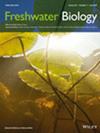藻类和土壤中的溶解有机物影响高海拔湖泊中细菌与浮游植物之间的相互作用
IF 2.8
2区 生物学
Q2 ECOLOGY
引用次数: 0
摘要
例如,增加细菌对有机基质的矿化作用可能会增加浮游植物的营养供应,从而对浮游植物生物量产生积极影响(Li 等人,2014 年)。高海拔湖泊通常为低营养型(Catalan 等人,2006 年),位于林木线以上,流域面积小且植被稀少。因此,营养物质供应和 DOC 浓度通常较低,DOM 显示出更多的自生荧光特征(Bastidas Navarro 等人,2014 年;Sommaruga & Augustin,2006 年)。但融雪期或极端降雨事件后是个例外,此时湖泊中的 DOM 池以同源 DOM 为主(Miller & McKnight,2010 年;Perga 等人,2018 年;Sadro 等人,2011 年)。因此,高海拔湖泊可能会对 DOM 数量和质量的变化做出强烈反应,就像这些生态系统(尤其是高寒地区)当前的全球变化所预期的那样(Ejarque 等人,2018 年)。一方面,由于气温升高和极端降水事件更加频繁,预计高海拔湖泊的陆地 DOC 输入会增加(IPCC,2021 年;Moser 等人,2019 年)。另一方面,气温升高和与之相关的冰盖期缩短,以及大气中氮(N;Kirchner 等人,2014 年;Kopáček 等人,2005 年)和磷(P;Kopàček 等人,2011 年)沉积增加,可能会显著促进浮游植物的发展(Bergström 等人,2005 年、2008 年;Camarero & al、本研究旨在模拟气候变化情景下两种可预测的 DOM 增加机制:自生生产和异源输入。为了探索 DOM 的变化如何影响浮游植物与 Hbact 的关系以及浮游植物群落结构,我们对高海拔科尔德斯湖的天然浮游生物群落进行了 4 × 2 × 2 的全因子设计,对三个因子进行了操作:DOM(C-对照、葡萄糖、藻类裂解液、土壤提取物)、营养物质(不添加营养物质、添加无机氮和磷)和光照(光暗循环、黑暗)。我们对以下假设进行了检验:在寡营养高海拔湖泊中,Hbact 受可溶性有机碳和无机营养物质(氮、磷)的共同限制。这种共同限制将限制单独添加葡萄糖和单独添加无机养分的 Hbact 的发展,导致 Hbact 的生物量和产量较低。此外,由于藻类溶胞物理论上具有更高的溶解能力,因此添加藻类溶胞物后,预计 DOC 的消耗量、Hbact 的生物量和产量都会增加。浮游植物的生物量会随着微生态系统中无机营养物质供应量的增加而增加,这是直接富集或与 Hbact 相互作用的结果。浮游植物的分类和功能组成将根据不同的处理方法发生变化,当细菌猎物丰富(Hbact 生物量高)、光照和/或营养物质限制自养时(即:在黑暗和未富集条件下),混养型浮游植物的比例较高、在黑暗环境和未富集营养物质的处理中)。本文章由计算机程序翻译,如有差异,请以英文原文为准。

Algal- and soil-derived dissolved organic matter shapes bacteria-phytoplankton interactions in a high-altitude lake
求助全文
通过发布文献求助,成功后即可免费获取论文全文。
去求助
来源期刊

Freshwater Biology
生物-海洋与淡水生物学
CiteScore
5.90
自引率
3.70%
发文量
162
审稿时长
2 months
期刊介绍:
Freshwater Biology publishes papers on all aspects of the ecology of inland waters, including rivers and lakes, ground waters, flood plains and other freshwater wetlands. We include studies of micro-organisms, algae, macrophytes, invertebrates, fish and other vertebrates, as well as those concerning whole systems and related physical and chemical aspects of the environment, provided that they have clear biological relevance.
Studies may focus at any level in the ecological hierarchy from physiological ecology and animal behaviour, through population dynamics and evolutionary genetics, to community interactions, biogeography and ecosystem functioning. They may also be at any scale: from microhabitat to landscape, and continental to global. Preference is given to research, whether meta-analytical, experimental, theoretical or descriptive, highlighting causal (ecological) mechanisms from which clearly stated hypotheses are derived. Manuscripts with an experimental or conceptual flavour are particularly welcome, as are those or which integrate laboratory and field work, and studies from less well researched areas of the world. Priority is given to submissions that are likely to interest a wide range of readers.
We encourage submission of papers well grounded in ecological theory that deal with issues related to the conservation and management of inland waters. Papers interpreting fundamental research in a way that makes clear its applied, strategic or socio-economic relevance are also welcome.
Review articles (FRESHWATER BIOLOGY REVIEWS) and discussion papers (OPINION) are also invited: these enable authors to publish high-quality material outside the constraints of standard research papers.
 求助内容:
求助内容: 应助结果提醒方式:
应助结果提醒方式:


